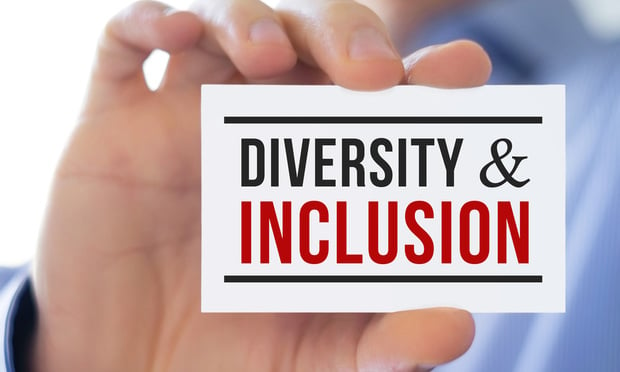Improving Diversity Through Inclusion: Get Asked to Dance
Studies have consistently shown that diverse environments—whether in the classroom or the board room—have better overall performance. And it is easy to see why. A room full of people with different backgrounds naturally has more viewpoints, talents and experiences to draw on. This, in turn, leads to more creativity and innovation as everyone works together.
April 06, 2018 at 03:09 PM
6 minute read

“Diversity is being invited to the party. Inclusion is being asked to dance.” —Vernā Myers
As a melting pot, America boasts people from different backgrounds—racial, ethnic, language, sexual orientation and more. It is this vast collection of experiences that makes America such an innovative and strong nation. Similarly, there have been countless studies showing the positive impact of diversity in the office. However, merely focusing on improving diversity by the numbers is a superficial and temporary solution. Diversity without inclusion is a hollow promise.
Studies have consistently shown that diverse environments—whether in the classroom or the boardroom—have better overall performance. And it is easy to see why. A room full of people with different backgrounds naturally has more viewpoints, talents and experiences to draw on. This, in turn, leads to more creativity and innovation as everyone works together.
And yet, many companies do not reflect this diversity, neither in the workforce nor in leadership. Sadder still, the legal profession is behind other professions in championing diversity. According to statistics from the U.S. Census Bureau, 80.9 percent of people employed in the legal sector are white; compare that to 74.3 percent in the business and financial sector, 72.7 percent in engineering, or 72.3 percent in health care. Looking to the legal profession specifically, the American Bar Association's National Lawyer Population Survey shows 85 percent of resident active attorneys are Caucasian/white, 5 percent African-American, 5 percent Hispanic and 2 percent Asian. The same study notes that 65 percent of lawyers are male, while 35 percent are female.
Diversity is also lacking in leadership positions. The 2017 Annual Report from the National Association of Women Lawyers shows that only 19 percent of equity partners are women—only a slight increase from 16 percent in 2007, and largely unchanged in the past 10 years. People of color make up about 6 percent of equity partners, women of color about 2 percent, openly LGBTQ people only 2 percent, and persons with disabilities less than 1 percent.
The National Association for Law Placement's 2017 Report on Diversity looks at these numbers nationwide, and also breaks it out by city. Nationwide, women make up just under 35 percent of total lawyers, while minorities are about 15 percent; in Philadelphia women are just over 35 percent of total lawyers but minorities are less than 10 percent. Nationwide, women make up about 23 percent of all partners, minorities about 8 percent; in Philadelphia specifically, women make up less than 20 percent of partners, minorities less than 6 percent. The report specifically notes that minority women are the “most dramatically under-represented group at the partnership level”; looking at the numbers, minority women make up just under 3 percent of all partners at law firms nationwide, and about 2 percent of partners in Philadelphia. As these statistics show, there is work to do.
Diversity is not just good for business, it is the right thing to do. For example, the comment to Rule 8.4 of the ABA Model Rules of Professional Conduct notes that it is professional misconduct to discriminate “on the basis of race, sex, religion, national origin, ethnicity, disability, age, sexual orientation, gender identity, marital status, or socioeconomic status in conduct related to the practice of law.” The comment further clarifies that this includes conduct which goes beyond representing clients, such as “operating or managing a law firm or law practice” or “participating in bar association, business, and social activities in connection with the practice of law.”
Some states are taking this further. For example, Rule 2-400 of California's Rules of Professional Conduct prohibits discriminatory practices in “hiring, promoting, discharging or otherwise determining the conditions of employment of any person; or accepting or terminating representation of any client.” Recognizing challenges to diversity in the profession, the Illinois bar now requires attorneys to take one hour of diversity and inclusion CLE during their two-year reporting period, as a way to increase engagement in diversity issues.
But improving diversity alone is not enough—we should be taking the extra step to foster an environment of inclusiveness as well. By embracing diversity through inclusion, firms will attract—and retain—diverse talent while creating a welcoming environment for all.
April happens to be “Celebrate Diversity Month.” I challenge you to embrace diversity through inclusion this April—and throughout the year—by highlighting and celebrating the different backgrounds of those you work with. Below are some ideas to get you started:
- Diversity committee: Have a dedicated committee to plan diversity and inclusion events throughout the year—activities can range from learning about a specific group each month, to planning fun events like a potluck or music festival in the office.
- Diversity bulletin board: Have a dedicated bulletin board for diversity. It can show diversity in general, highlight a specific diverse group, or be a place for diverse associates to post and engage the office. Or have multiple boards throughout the office, celebrating all diverse groups throughout the year.
- Diversity speakers: Bring in a speaker or a panel to discuss diversity, either a personal path or diversity in general. Or look in your own firm for people to share their own stories.
- Volunteer: Join or volunteer with a diverse organization, legal or otherwise. Diverse associates may already be doing pro bono work with these organizations, and can help set up clinics or other events. Not only will your group be helping others, but they will also be learning about diversity at the same time.
- Be mindful: Recognize and encourage diverse associates, and consciously make the effort to include rather than defaulting to people who are safe or comfortable.
- Practice inclusion across your business: Answer your phone, have an open door, sit with people outside your immediate team—all these actions show you are open and accessible. By practicing inclusion throughout the day, diversity and inclusion will soon be second nature.
Creating an environment where everyone feels comfortable, safe and valued will only strengthen your business. By having a diverse team, you will provide stronger representation for your clients, see more innovation in your business, and create a more collegial work environment. The ideas above are just a starting point. Together, we can make the legal profession welcoming for everyone.
Lydia Abdo is an attorney at Robert J. Casey Jr. and Associates where she handles third-party litigation for State Farm.
This content has been archived. It is available through our partners, LexisNexis® and Bloomberg Law.
To view this content, please continue to their sites.
Not a Lexis Subscriber?
Subscribe Now
Not a Bloomberg Law Subscriber?
Subscribe Now
NOT FOR REPRINT
© 2025 ALM Global, LLC, All Rights Reserved. Request academic re-use from www.copyright.com. All other uses, submit a request to [email protected]. For more information visit Asset & Logo Licensing.
You Might Like
View All
With New Civil Jury Selection Rule, Litigants Should Carefully Weigh Waiver Risks
6 minute read


Government, May I Fix My GST Mistake? Regulations Offer Guidance on Generation-Skipping Tax Exemption Allocation Relief
9 minute readTrending Stories
Who Got The Work
J. Brugh Lower of Gibbons has entered an appearance for industrial equipment supplier Devco Corporation in a pending trademark infringement lawsuit. The suit, accusing the defendant of selling knock-off Graco products, was filed Dec. 18 in New Jersey District Court by Rivkin Radler on behalf of Graco Inc. and Graco Minnesota. The case, assigned to U.S. District Judge Zahid N. Quraishi, is 3:24-cv-11294, Graco Inc. et al v. Devco Corporation.
Who Got The Work
Rebecca Maller-Stein and Kent A. Yalowitz of Arnold & Porter Kaye Scholer have entered their appearances for Hanaco Venture Capital and its executives, Lior Prosor and David Frankel, in a pending securities lawsuit. The action, filed on Dec. 24 in New York Southern District Court by Zell, Aron & Co. on behalf of Goldeneye Advisors, accuses the defendants of negligently and fraudulently managing the plaintiff's $1 million investment. The case, assigned to U.S. District Judge Vernon S. Broderick, is 1:24-cv-09918, Goldeneye Advisors, LLC v. Hanaco Venture Capital, Ltd. et al.
Who Got The Work
Attorneys from A&O Shearman has stepped in as defense counsel for Toronto-Dominion Bank and other defendants in a pending securities class action. The suit, filed Dec. 11 in New York Southern District Court by Bleichmar Fonti & Auld, accuses the defendants of concealing the bank's 'pervasive' deficiencies in regards to its compliance with the Bank Secrecy Act and the quality of its anti-money laundering controls. The case, assigned to U.S. District Judge Arun Subramanian, is 1:24-cv-09445, Gonzalez v. The Toronto-Dominion Bank et al.
Who Got The Work
Crown Castle International, a Pennsylvania company providing shared communications infrastructure, has turned to Luke D. Wolf of Gordon Rees Scully Mansukhani to fend off a pending breach-of-contract lawsuit. The court action, filed Nov. 25 in Michigan Eastern District Court by Hooper Hathaway PC on behalf of The Town Residences LLC, accuses Crown Castle of failing to transfer approximately $30,000 in utility payments from T-Mobile in breach of a roof-top lease and assignment agreement. The case, assigned to U.S. District Judge Susan K. Declercq, is 2:24-cv-13131, The Town Residences LLC v. T-Mobile US, Inc. et al.
Who Got The Work
Wilfred P. Coronato and Daniel M. Schwartz of McCarter & English have stepped in as defense counsel to Electrolux Home Products Inc. in a pending product liability lawsuit. The court action, filed Nov. 26 in New York Eastern District Court by Poulos Lopiccolo PC and Nagel Rice LLP on behalf of David Stern, alleges that the defendant's refrigerators’ drawers and shelving repeatedly break and fall apart within months after purchase. The case, assigned to U.S. District Judge Joan M. Azrack, is 2:24-cv-08204, Stern v. Electrolux Home Products, Inc.
Featured Firms
Law Offices of Gary Martin Hays & Associates, P.C.
(470) 294-1674
Law Offices of Mark E. Salomone
(857) 444-6468
Smith & Hassler
(713) 739-1250





